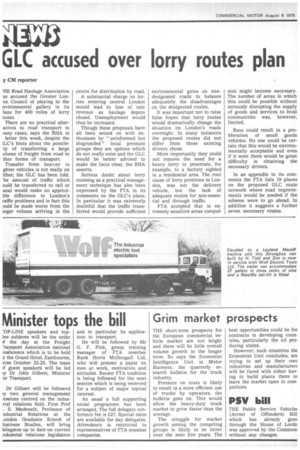GLC accused over lorry routes plan
Page 6

If you've noticed an error in this article please click here to report it so we can fix it.
y CM reporter
HE Road Haulage Association as accused the Greater Lonon Council of playing to the nvircrnmental gallery in its lans for 400 miles of lorry mites.
There are no practical alteratives to road transport in lany cases, says the RHA in letter this week, despite the irLC's hints about the possibity of transferring a large olume of freight from road to ther forms of transport.
Transfer from heavier to ghter vehicles is not really on ither, the GLC has been told. he amount of traffic which ould be transferred to rail or anal would make no apprecible difference to London's raffle problems and in fact this ould be made worse from the arger volume arriving iri the centre for distribution by road.
A substantial charge on lorries entering central London would lead to loss of rate revenue as haulage depots closed. Unemployment would thus be increased.
Though these proposals have all been seized on with enthusiasm by "uninformed but disgruntled " local pressure groups they are options which do not really exist and the GLC would be better advised to make the facts clear, the RHA asserts.
Serious doubt about lorry routeing as a practical management technique has also been expressed by the FTA in its comments on the GLC's plans. In particular it was extremely doubtful that the traffic transferred would provide sufficient environmental gains on nondesignated roads to balance adequately the disadvantages on the designated routes.
It was important not to raise false hopes that lorry routes would dramatically change the situation on London's roads overnight. In many instances the proposed routes did not differ from those existing drivers chose.
More importantly they could not remove the need for a heavy lorry to penetrate, for example, to a factory sighted in a residential area. The root cause of lorry problems in London, was not the delivery vehicle, but the lack of adequate routes for non-essential and through traffic.
FTA accepted that in extremely sensitive areas .compul sion might become necessary. The number of areas in which this could be possible without seriously disrupting the supply of goods and services to local communities was, however, limited.
Bans could result in a proliferation of small goods vehicles. No one could be certain that this would be environmentally acceptable and even if it were there would be great difficulty in obtaining the necessary drivers.
In an appendix to its comments the FTA lists 19 places on the proposed GLC route network where road improvements would be needed if the scheme were to go ahead. In addition it suggests a further seven necessary routes.




































































































